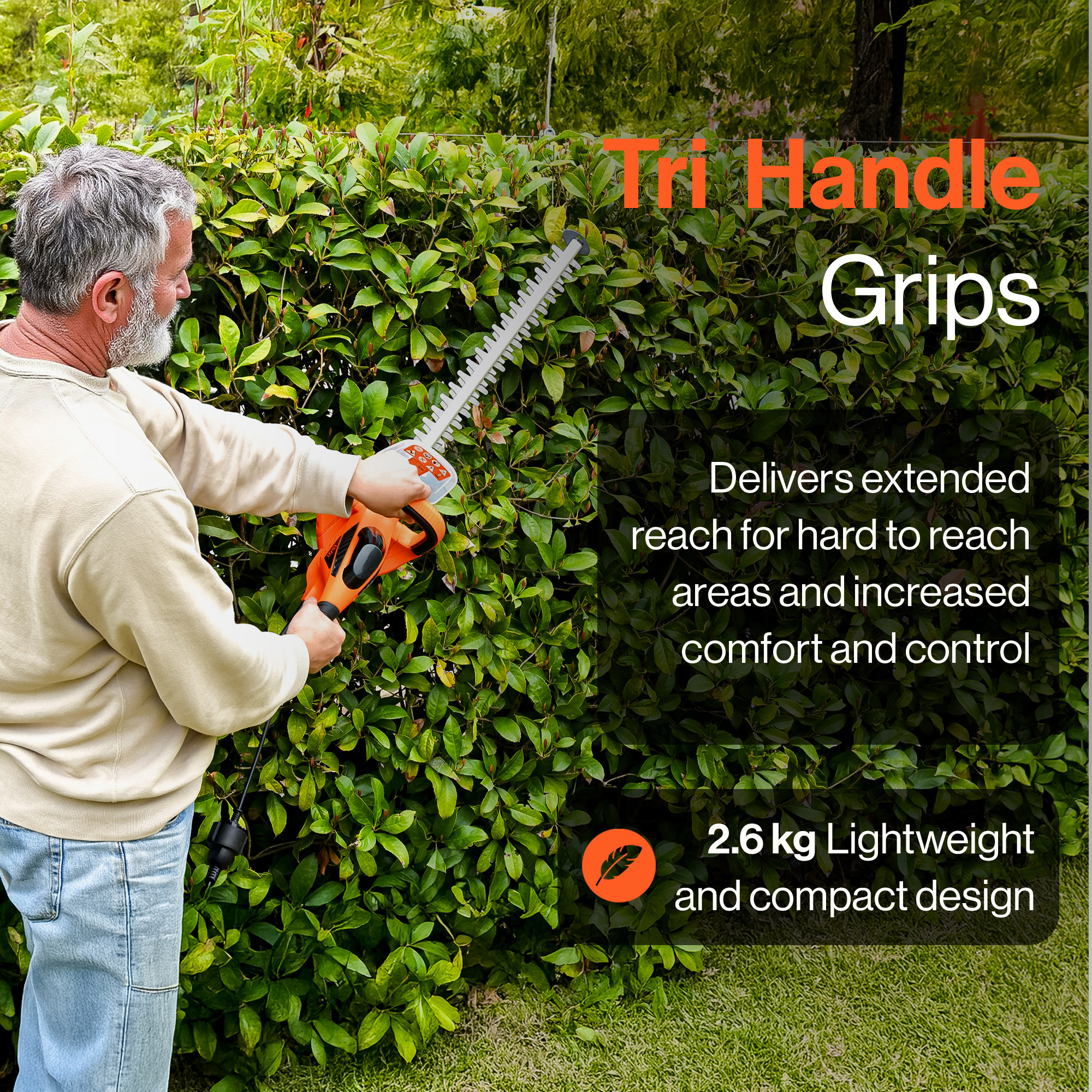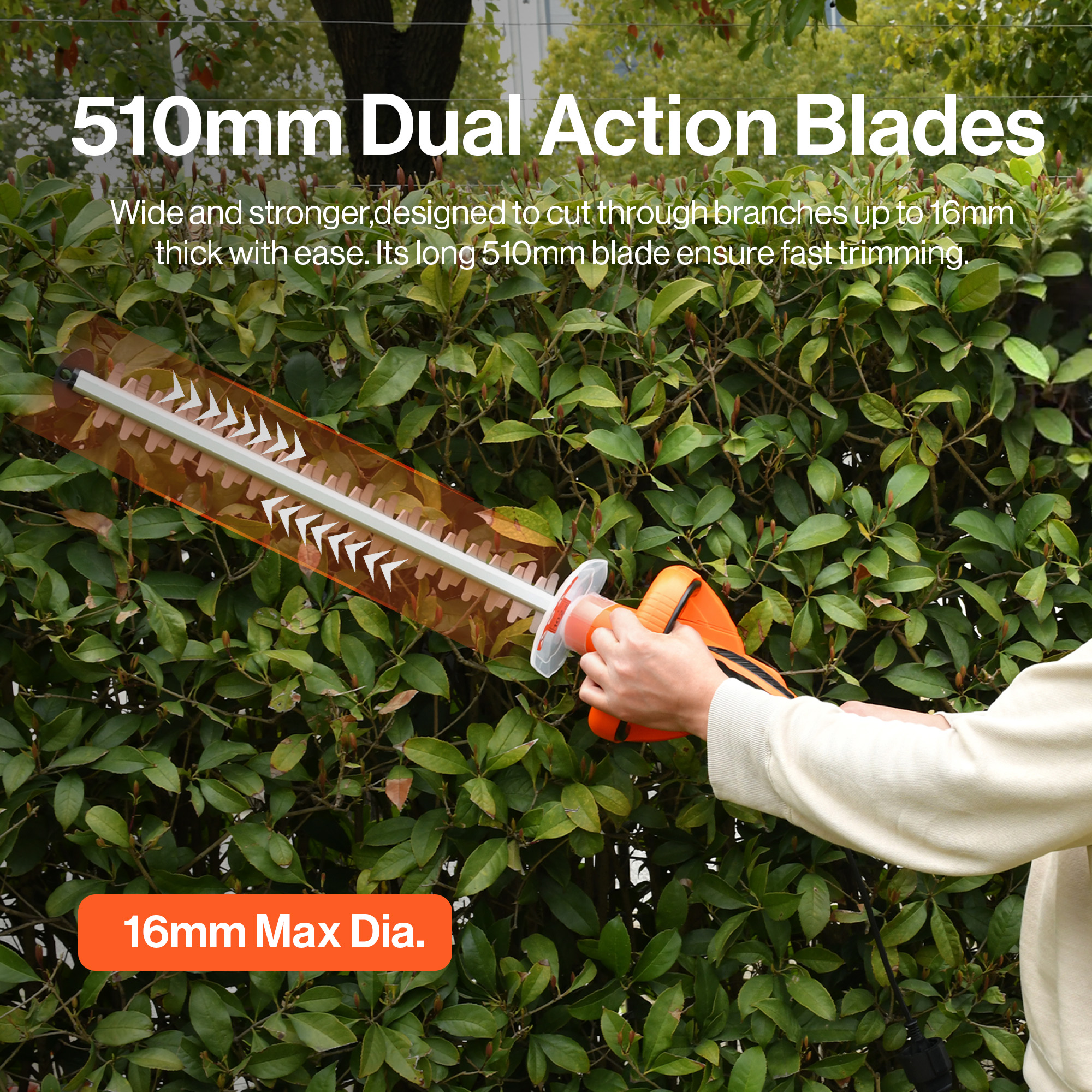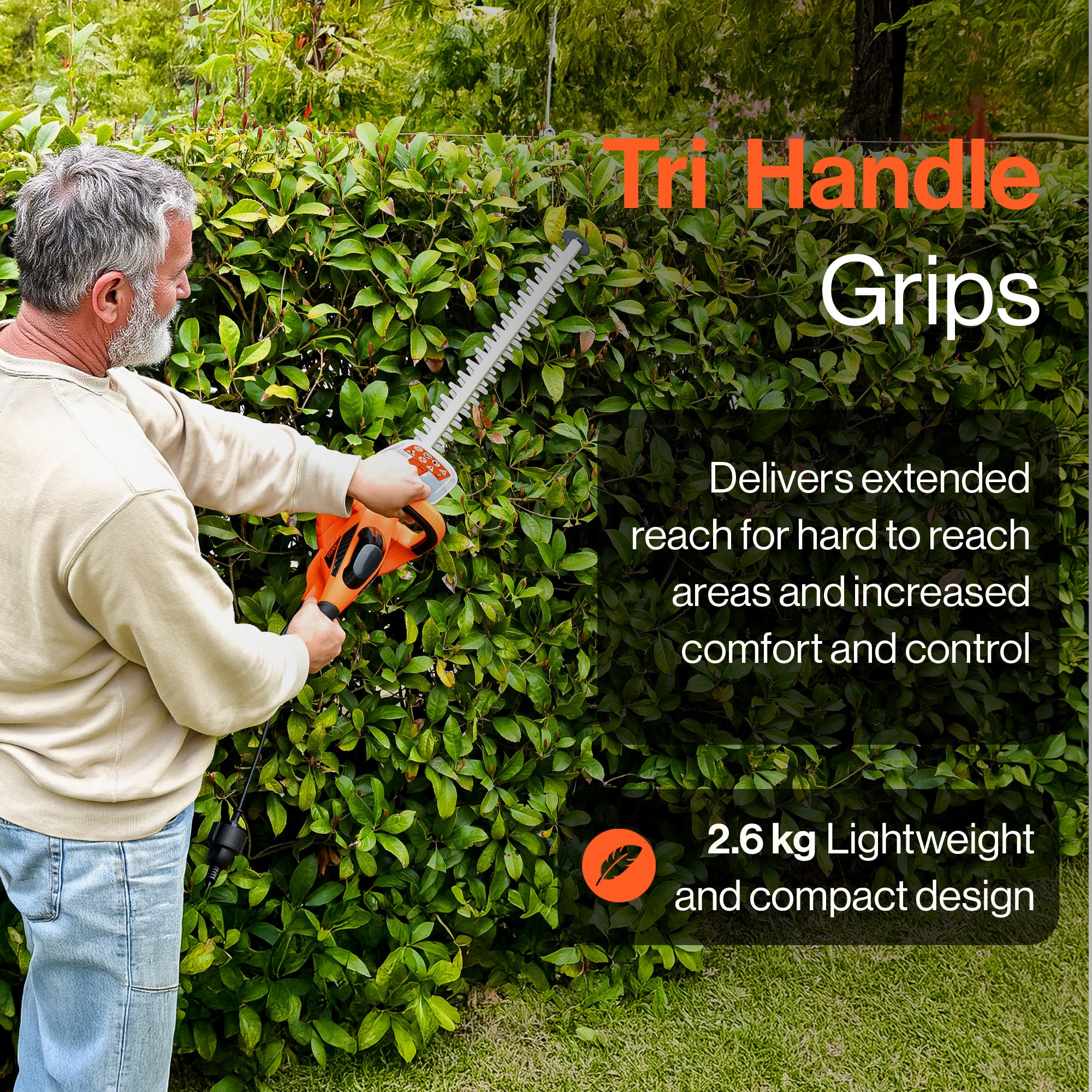
Choosing the right hedge trimmer can be confusing.
There are many types to pick from.
Think about your hedge’s size and type.
Also, check if you can reach all parts of your garden.
More people are buying hedge trimmers every year.
Gardens use over half of all hedge trimmers sold.
The market grows by 5.5% each year.
Metric/Segment |
Data/Value |
What it Means |
|---|---|---|
Gardens Market Share |
Over 50% |
Most trimmers are used in gardens |
CAGR (2022-2030) |
5.5% |
The market is growing every year |
You might have a small box hedge.
Box hedges grow slowly and stay short.
A pyracantha hedge grows fast and needs more care.
Some hedges, like holly or bamboo, can get very tall.
If you do not trim them, they keep growing.
Fast-growing hedges need trimming often to look tidy and safe.
Key Takeaways
Pick a hedge trimmer that fits your hedge size and garden shape.
Choose petrol for large jobs, battery for medium gardens, and corded for small gardens near plugs.
Select a blade length and type that matches your hedge and strength.
Find trimmers that are light, easy to use, and have safety parts like blade covers and safety switches.
Think about price, running costs, and extras before buying for good value and long use.
Garden Needs

Hedge Size
You should always start by looking at the size of your hedge. Small hedges, like box or privet, need less power and a shorter blade. Large hedges, such as laurel or leylandii, grow tall and wide. These hedges need a hedge trimmer with a longer blade and more power. If you have a big hedge, you will save time with a tool that can cut more in one pass.
Tip: Measure your hedge before you buy a hedge trimmer. This helps you pick the right size and power.
Accessibility
Think about how easy it is to reach all parts of your hedge. Some hedges grow close to fences or walls. Others may stand alone in the middle of your garden. If your hedge sits in a tight spot, you need a lightweight hedge trimmer that is easy to handle. For tall hedges, you may want a trimmer with a telescopic handle.
Check if you can move around your hedge freely.
Look for obstacles like garden furniture or trees.
Choose a hedge trimmer that lets you trim safely and comfortably.
Maintenance Frequency
How often you trim your hedge affects your choice. Fast-growing hedges need regular trimming. Slow-growing hedges need less work. If you do hedge garden maintenance every few weeks, you want a hedge trimmer that feels light and easy to use.
Note: Regular trimming keeps your hedge healthy and neat. It also stops it from getting too thick or tall.
You should match your hedge trimmer to your hedge and your routine. This makes hedge garden maintenance easier and safer.
Types of Hedge Trimmers
You need to know the main types of hedge trimmers. Each type is best for certain gardens and hedge shapes. Here are the basics:
Corded Electric
Corded electric hedge trimmers plug into a socket. They give steady power if plugged in. These trimmers weigh about 3 to 5 kg. The blades are 47–56 cm long. They cut branches up to 16 mm thick. You can use them as long as they are plugged in.
Tip: Corded electric hedge trimmers are good for small or medium gardens near your house.
Feature |
Corded Electric Hedge Trimmer |
|---|---|
Power Consumption |
300W to 750W |
Running Time |
Unlimited (while plugged in) |
Weight |
3–5 kg |
Blade Length |
47–56 cm |
Branch Thickness Cut |
Up to 16 mm |
Mobility |
Limited by cord |
Cost |
Lower initial cost |
Pros:
Power is always steady
Lighter than petrol types
Cheaper to buy
Cons:
Cord can get in the way
Not good for big gardens or far hedges
Cordless Battery
Cordless battery hedge trimmers use batteries you can recharge. You can move around without a cord. Most batteries last 30–80 minutes.
Note: Cordless hedge trimmers are good for medium gardens and hedges far from plugs.
Pros:
Easy to move
Quieter than petrol
No fumes
Cons:
Runs out of battery
Needs charging
A bit heavier than corded ones
Petrol
Petrol hedge trimmers use fuel to work. They are strong and cut thick or long hedges. These are best for big gardens or hard jobs. Brands like Honda and STIHL are tough and comfy to use.
Petrol hedge trimmers are for big gardens, tall hedges, or pro jobs.
Pros:
Very powerful
No cord or battery needed
Cuts thick branches
Cons:
Heavy and loud
Needs fuel and care
Makes fumes
Manual
Manual hedge trimmers like shears need your strength. You control each cut. They are good for shaping small hedges. These tools are best for small gardens or careful work.
Manual hedge trimmers are good for small hedges, topiary, or quiet places.
Aspect |
Manual Hedge Trimmers |
|---|---|
Power Source |
Human effort |
Weight |
Light |
Cutting Efficiency |
Lower, depends on user |
Maintenance |
Simple (cleaning, sharpening) |
Environmental Impact |
No noise or fumes |
Pros:
Quiet and green
You control the cuts
Cheap to buy
Cons:
Hard work for big hedges
Slower than powered types
When picking a hedge trimmer, think about your hedge size, garden shape, and how often you trim. Corded and cordless types fit most home gardens. Petrol is best for big or tough hedges. Manual tools are for small jobs or neat shapes.
How to Choose a Hedge Trimmer
Picking a hedge trimmer is not just about looks.
You must find one that fits your garden’s needs.
This part shows how to pick by looking at power, blade, weight, and safety.
Power Source
The power type changes how you use your trimmer.
You can pick petrol, battery, or corded electric models.
Each one works best for different gardens and jobs.
Petrol trimmers are the strongest.
They cut thick branches and big hedges.
They last long but are heavy and loud.Battery trimmers have no cord.
They are good for medium gardens.
They are quieter than petrol trimmers.Corded trimmers are light and easy to use.
They work best in small gardens near a plug.
The cord can stop you moving far.
Feature |
Petrol |
Battery-Powered |
Corded Electric |
|---|---|---|---|
Power |
High |
Medium |
Medium |
Mobility |
Unlimited |
Unlimited |
Limited by cord |
Noise |
High |
Low |
Low |
Weight |
Heavy |
Light to medium |
Light |
Best for |
Large, tough hedges |
Medium gardens |
Small gardens |
Tip: For battery trimmers, check the voltage.
More volts mean more power for hard jobs.
Blade Length
Blade length tells you how much you cut at once.
Long blades trim wide hedges fast.
Short blades help you shape and do detail work.
Most people use blades between 20 and 26 inches.
This size gives you both reach and control.
Most trimmers cut branches up to 3/4 inch thick.
Some strong trimmers cut even thicker branches.
Blade Type
Blade type changes how well your trimmer cuts.
Most trimmers use dual-action blades.
These move both ways for smooth cuts and less shaking.
Single-sided blades are lighter and good for straight hedges.
Look for blades made from strong steel.
Laser-cut or hardened steel lasts longer and stays sharp.
The tooth gap shows how thick a branch you can cut.
Wider gaps cut thicker branches.
Specification |
Details |
|---|---|
Blade length |
55 cm |
Blade gap |
19 mm |
Blade type/material |
Dual-action, laser-cut, hardened steel |
Cutting capacity |
Up to 33 mm (about 1.3 inches) |
Tip: Check if blades are sharp before you start.
Sharp blades cut better and help the motor last.
Weight and Ergonomics
Weight and design help you use the trimmer safely.
Light trimmers are easier to use for a long time.
Balanced tools are easier to control and less tiring.
Light trimmers (under 3 kg) fit most home gardens.
Medium weight (3–5 kg) is good for bigger jobs.
Heavy trimmers (over 5 kg) are strong but tire your arms.
Handles made of rubber or plastic give a good grip.
Some handles move to fit your hand or angle.
Anti-vibration parts help your hands and arms feel better.
Many people say a comfy handle makes trimming safer and easier.
Safety Features
Safety features keep you safe while you work.
Look for a safety switch that stops blades if you let go.
Blade guards stop your hands touching the blades.
Some trimmers have barriers around the grip for extra safety.
Safety Feature |
Purpose |
|---|---|
Safety switch |
Stops blades when released |
Blade guard |
Shields hands from moving blades |
Grip zone barrier |
Prevents accidental contact |
CE certification |
Meets European safety standards |
TÜV Rheinland and CE marks show the trimmer is safe.
Makers test these features to make sure they work well.
Always check for safety marks before you buy.
This helps you stay away from unsafe trimmers.
Noise and Vibration
Noise and shaking can make you tired or hurt.
Petrol trimmers are the loudest, over 85 dBA.
Electric and battery trimmers are much quieter.
High vibration can hurt your hands and arms.
Rubber mounts and anti-vibration handles help a lot.
Some studies show these can cut vibration by half.
Wear ear defenders if your trimmer is loud.
Pick a trimmer with low vibration for safer use.
When picking a hedge trimmer, match it to your garden.
Check the power, blade, comfort, and safety.
Clean and sharpen the blades often to keep it working well.
Pick a trusted brand with good reviews and a strong warranty for peace of mind.
Factors to Think About When Buying a Hedge Trimmer
Accessories
Accessories help make trimming safer and easier.
Some trimmers come with blade covers or shoulder straps.
Extra batteries are useful for cordless trimmers.
A long handle helps you reach tall hedges.
A blade sharpener keeps your trimmer working well.
Many people now want smart extras, like app controls.
Anti-vibration handles make trimming more comfy and safe.
Check what is in the box before you buy a trimmer.
Durability and Maintenance
Pick a hedge trimmer that is strong and lasts long.
Good blades cut thick branches without getting stuck.
Battery trimmers with long life are best for heavy jobs.
Safety parts like anti-jam and blade guards keep you safe.
It is important to clean and sharpen your trimmer often.
Easy cleaning and spare parts help your trimmer last longer.
A good warranty makes you feel safe about your buy.
Trusted brands make it easy to get help or new parts.
Clean and care for your trimmer to help it last for years.
You should always start by looking at your hedge and garden needs. Compare the different types of hedge trimmers to see which one matches your hedge size and shape. Focus on features that help you work faster and keep your hedge healthy. Set a budget before you buy. Check reviews and look for tips on safety and care. A good choice will make hedge trimming easier and help your hedge look its best.
FAQ
How often should you sharpen hedge trimmer blades?
You should sharpen your blades after every 20 to 30 hours of use. Dull blades make trimming harder and can damage your hedge. Use a sharpening stone or file. Always unplug or remove the battery before you start.
Can you use a hedge trimmer for branches?
You can cut small branches with most hedge trimmers. Check the blade gap and cutting capacity in the manual. For thick branches over 2 cm, use loppers or a pruning saw instead.
What safety gear do you need when using a hedge trimmer?
Always wear gloves, safety glasses, and sturdy shoes. Ear defenders help if your trimmer is loud. Long sleeves protect your arms from scratches.
How do you store a hedge trimmer safely?
Clean the blades after each use.
Cover the blades with a guard.
Store the trimmer in a dry place, out of children’s reach.
Storage Tip |
Why It Matters |
|---|---|
Clean blades |
Stops rust |
Use blade cover |
Prevents accidents |
Dry storage |
Protects the motor |

